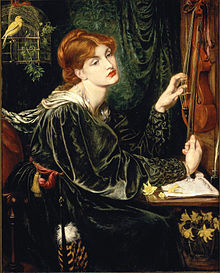
Gabriel Charles Dante Rossetti, generally known as Dante Gabriel Rossetti, was an English poet, illustrator, painter, translator and member of the Rossetti family. He founded the Pre-Raphaelite Brotherhood in 1848 with William Holman Hunt and John Everett Millais. Rossetti inspired the next generation of artists and writers, William Morris and Edward Burne-Jones in particular. His work also influenced the European Symbolists and was a major precursor of the Aesthetic movement.
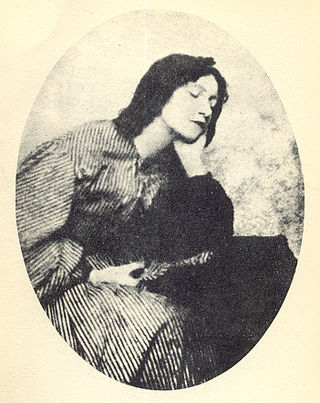
Elizabeth Eleanor Siddall, better known as Elizabeth Siddal, was an English artist, artists' model, and poet. Siddal was perhaps the most significant of the female models who posed for the Pre-Raphaelite Brotherhood. Their ideas of female beauty were fundamentally influenced and personified by her. Walter Deverell and William Holman Hunt painted Siddal, and she was the model for John Everett Millais's famous painting Ophelia (1852). Early in her relationship with Dante Gabriel Rossetti, Siddal became his muse and exclusive model, and he portrayed her in almost all his early artwork depicting women.
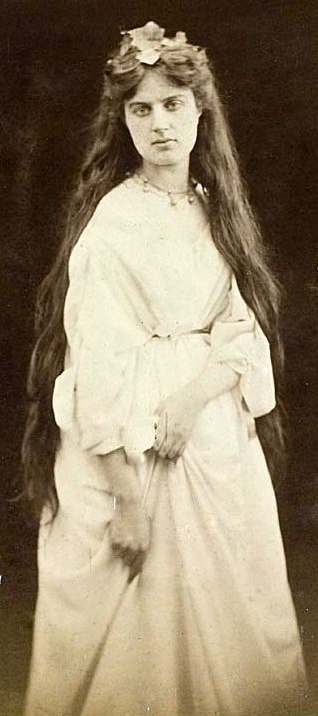
Marie Stillman was a British member of the second generation of the Pre-Raphaelite Brotherhood. Of the Pre-Raphaelites, she had one of the longest-running careers, spanning sixty years and producing over one hundred and fifty works. Though her work with the Brotherhood began as a favourite model, she soon trained and became a respected painter, earning praise from Dante Gabriel Rossetti and others.
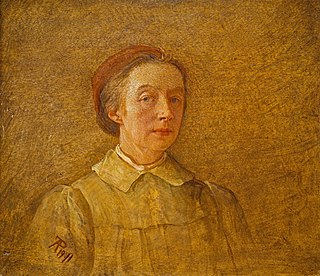
Phoebe Anna Traquair was an Irish-born artist, who achieved international recognition for her role in the Arts and Crafts movement in Scotland, as an illustrator, painter and embroiderer. Her works included large-scale murals, embroidery, enamel jewellery and book illuminations. In 1920, she was elected as an honorary member of the Royal Scottish Academy.

A Vision of Fiammetta is an oil painting created by Dante Gabriel Rossetti, in the Pre-Raphaelite style, created in 1878. The painting was one half of one of Rossetti's "double works", accompanying his Ballads and Sonnets (1881). Maria Spartali Stillman modelled for the painting. The subject of painting is Boccaccio's muse named Fiammetta.

"The Blessed Damozel" is perhaps the best known poem by Dante Gabriel Rossetti, as well as the title of his painting illustrating the subject. The poem was first published in 1850 in the Pre-Raphaelite journal The Germ. Rossetti subsequently revised the poem twice and republished it in 1856, 1870 and 1873.

Beata Beatrix is a painting completed in several versions by Pre-Raphaelite artist Dante Gabriel Rossetti. The painting depicts Beatrice Portinari from Dante Alighieri's 1294 poem La Vita Nuova at the moment of her death. The first version is oil on canvas completed in 1870.
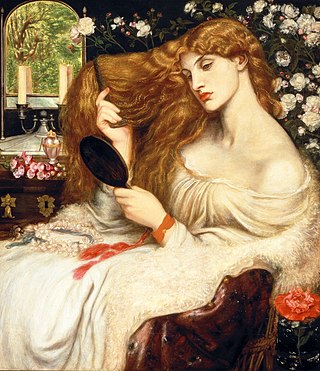
Lady Lilith is an oil painting by Dante Gabriel Rossetti first painted in 1866–1868 using his mistress Fanny Cornforth as the model, then altered in 1872–73 to show the face of Alexa Wilding. The subject is Lilith, who was, according to ancient Judaic myth, "the first wife of Adam" and is associated with the seduction of men and the murder of children. She is shown as a "powerful and evil temptress" and as "an iconic, Amazon-like female with long, flowing hair."
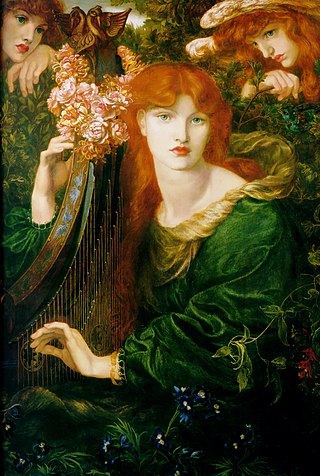
Alexa Wilding was one of the favourite models of the Pre-Raphaelite artist Dante Gabriel Rossetti, featuring in some of his finest paintings of the later 1860s and 1870s. She sat for more of his finished works than any other of his more well-known muses, including Elizabeth Siddall, Jane Morris and Fanny Cornforth.

Found is an unfinished oil painting by Dante Gabriel Rossetti, now in the Delaware Art Museum. The painting is Rossetti's only treatment in oil of a contemporary moral subject, urban prostitution, and although the work remained incomplete at Rossetti's death in 1882, he always considered it one of his most important works, returning to it many times from the mid-1850s until the year before his death.
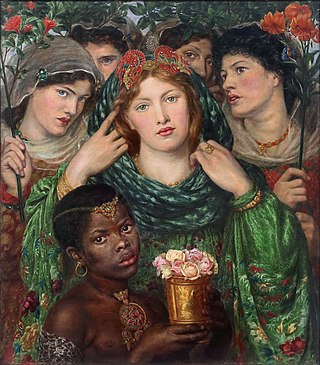
The Beloved is an oil painting on canvas by the English artist Dante Gabriel Rossetti (1828–1882), now in Tate Britain, London. Rossetti signed his initials and the date as "1865-6" on the bottom left of the canvas. It depicts the bride, or "beloved", from the Song of Solomon in the Hebrew Bible as she approaches her bridegroom, with her attendants.

Pia de' Tolomei is an oil painting on canvas by English artist Dante Gabriel Rossetti, painted around 1868 and now in the Spencer Museum of Art, on the campus of the University of Kansas in Lawrence, Kansas.

Proserpine is an oil painting on canvas by English artist and poet Dante Gabriel Rossetti, painted in 1874 and now in Tate Britain. Rossetti began work on the painting in 1871 and painted at least eight separate versions, the last only completed in 1882, the year of his death. Early versions were promised to Charles Augustus Howell. The painting discussed in this article is the so-called seventh version commissioned by Frederick Richards Leyland, now at the Tate Gallery, with the very similar final version now at the Birmingham Museum and Art Gallery.

Mnemosyne, also titled Lamp of Memory and Ricordanza, is an oil painting by Dante Gabriel Rossetti begun in 1875 or early 1876 and completed in 1881. Jane Morris was the model, and Frederick Richards Leyland bought the painting in 1881 and displayed it in his drawing room with five other Rossetti "stunners." At about the same time Rossetti, a founder of the Pre-Raphaelite Brotherhood, was painting Astarte Syriaca, a larger painting completed in 1877 with Morris in a very similar pose.

Veronica Veronese is an oil painting by Dante Gabriel Rossetti painted in 1872 with Alexa Wilding as the model. The painting was conceived as a companion to Lady Lilith. Rossetti sold the painting to one of his best clients, shipping magnate Frederick Richards Leyland. In 1923 it was acquired by the estate of Samuel Bancroft which donated it in 1935 to the Delaware Art Museum.

Monna Rosa is the title of two oil paintings by Dante Gabriel Rossetti, both portraits of Frances Leyland, the wife of shipping magnate Frederick Richards Leyland, a regular patron of Rossetti. The earlier and smaller painting was completed in 1862 and its whereabouts is now unknown. The second was completed in 1867 and is now in a private collection.
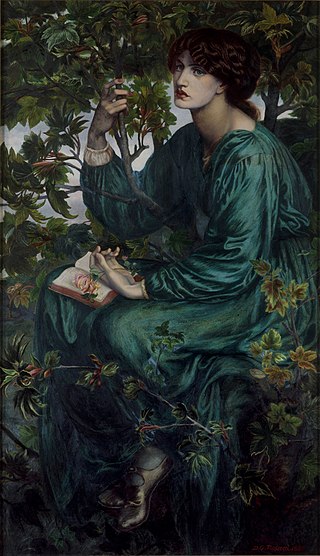
The Day Dream or, as it was initially intended to be named, Monna Primavera, is an oil-on-canvas painting by the Pre-Raphaelite Brotherhood founder member Dante Gabriel Rossetti. The work, which measures 158.7 centimetres (62.5 in) high by 92.7 centimetres (36.5 in) wide, was undertaken in 1880 and depicts Jane Morris in a seated position on the bough of a sycamore tree. In her hand is a small stem of honeysuckle – a token of love in the Victorian era – that may be an indication of the secret affair the artist was immersed in with her at the time. The artwork was left to the Victoria and Albert Museum by Constantine Alexander Ionides in 1900.

Ligeia Siren is a chalk drawing by Dante Gabriel Rossetti (DGR) that was completed in 1873. The painting depicts a siren, a creature from classic Greek mythology, that also appear in tales such as Homer's Odyssey or Virgil's Georgics. The drawing is predominantly inspired from Rossetti's own 1869 libretto The Doom of the Sirens with which Ligeia is one of the female leads. Instead of depicting the traditional encounter of the siren with her victims entranced by her beauty and powers of music, doomed to a terrible fate, as in The Siren (1900) by John William Waterhouse or Ulysses and the Sirens (1909) by Herbert James Draper. Rossetti depicts a timeless moment, where contrary to his depiction of her in his libretto, she appears tranquil and relatively innocuous to her intended victims in the background.

Venus Verticordia (1864–1868) by Dante Gabriel Rossetti is a semi-nude depiction of the goddess Venus, portrayed as a young woman with a golden halo and flowing auburn hair, surrounded by pink flowers in a dark, lush green garden. Her left breast is visible, the right obscured by the golden apple she holds in her left hand. In her right hand she holds an arrow, the point directed towards her own heart, and on which rests a small yellow butterfly. Other similar butterflies ring the halo surrounding her head, and another sits on top of the apple she holds.

Roman Widow or Dîs Manibus is an oil on canvas painting executed in 1874 by the English Pre-Raphaelite artist Dante Gabriel Rossetti. It is in the collection of the Museo de Arte de Ponce in Puerto Rico.


